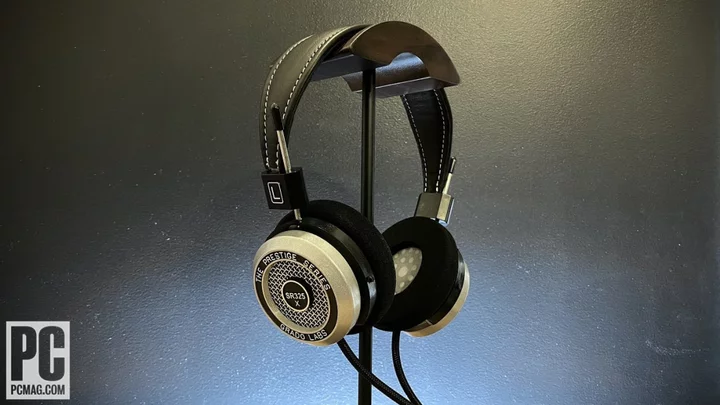Many of Grado's headphones are prohibitively expensive, so we're happy to see that the top-end model in its Prestige Series, the SR325x, comes in at a fairly reasonable $295. These open-back headphones produce a wide, realistic stereo image and deliver a sublime blend of low-frequency richness and high-frequency detail. And unlike most modern headphones we test, they give plenty of attention to the midrange, too. The pair can handle any genre with aplomb, but tracks with a spatial character, like those from Bach or Led Zeppelin, sound particularly fantastic. If you are looking to break into the audiophile segment without obliterating your budget, the Grado SR325x headphones offer a rewarding listening experience and are thus an Editors' Choice award winner.
An Open, Upscale Design
The open design of these headphones is somewhat unique. The shape of the standard foam earpads, in combination with the loose, swivel-mount action of the enclosures, make for a comfortable fit. The supra-aural (or on-ear) earpads don't create a seal, which means you can easily hear your surroundings. The headphones still stay securely in place while you listen, but it might take you a bit of time to adjust to the lighter, looser feel if you’ve never worn a pair of Grados before. Thankfully, they don't create as much pressure on your head as many other on-ear models.
(Credit: Tim Gideon)The circular ear enclosures sport the signature Grado look—an engraving of the model name graces the ring that surrounds the outer grilles, while fit adjusters with large L and R markings sit at either end of a retro, black-leather-and-white-stitch headband.
A few aspects make the headphones a better fit for home use despite the standout design. For instance, the thick hardwired cable has a tough, woven sleeve that's somewhat rigid and thus not ideal for portability. And their open-back design means they leak audio, which makes them a hard sell for crowded environments or an office. That latter quality results in exceptional spatial imaging, however, as I discuss later.
Each enclosure houses a 44mm dynamic driver that delivers a frequency range of 18Hz to 24kHz with an impedance of 38 ohms.
On the Grado website, you can choose between different styles of earpads for the SR325x headphones: F (the standard option for this model), S ($17.50), L ($32.50), and G ($55.00). You can also get an extra pair of F cushions for $32.50. Grado says the flat F cushions increase the bass response because they bring the driver closer to your ear, while the more cone-like L cushions open up the response. Your real-world experience is likely to depend on factors such as your ear shape and preference, but it's worth checking out audio forums for user impressions of the various earpad options.
I would have liked Grado to include at least a simple drawstring pouch with the headphones, but the package has just a quarter-inch headphone jack adapter. Grado sells various hard-shell cases (starting at $49.95) if you must have one. You can add a wooden stand (starting at $179) or a storage box (starting at $110) to your order, but these accessories aren’t cheap.
Another minor complaint is that you can't remove the wire without taking apart the earcups. This isn't a deal breaker, but plenty of competing models have removable cables and ship with an array of wires to suit your needs (for example, in various lengths, with or without coils, or with varying sleeve thicknesses). These quibbles aside, the headphones are a pure joy to use.
(Credit: Tim Gideon)There’s no app for these headphones, no wireless functionality, no mic or remote for the cable, no battery life to worry about, and no active noise cancellation. You can argue that the open design leads to a transparency-like listening mode, but the focus here is purely on audio quality.
Superb, Balanced Sonics
I tested the SR325x headphones via a MacBook Pro's headphone jack and a variety of sound sources via a McIntosh stereo receiver.
On tracks with intense sub-bass content, like The Knife’s “Silent Shout,” the headphones match palpable low-frequency thump with higher-frequency clarity. The sub-bass doesn’t distort at top volumes (though it's possible to push them too far with some sources). At more reasonable volume levels, the lows still sound robust and complementary with the mids and highs.
They have no issues reproducing the sub-bass at the 34-second mark of Kendrick Lamar’s “Loyalty.” The very deepest of these synth bass notes is just at the edge of their frequency range, but it comes across clearly with a solid sense of rumble. Just note that if you are seeking a boosted, subwoofer-like experience, their measured delivery might not appeal. The various vocals sound excellent, with plenty of high-frequency clarity.
(Credit: Tim Gideon)The drums on Bill Callahan’s “Drover,” a track with far less deep bass, sound full-bodied and realistic. Callahan’s baritone vocals receive an ideal blend of low-mid richness and high-mid detail, while the higher-register percussive hits and acoustic strums are airy and bright. The SR325x headphones deliver more of the midrange than most mainstream models, so the response throughout the frequency range sounds fairly even.
On orchestral tracks, like the opening scene from John Adams’ The Gospel According to the Other Mary, the headphones perform magnificently. Short of attending a live concert or listening to a surround recording of a classical piece on a proper surround speaker system, it’s hard to imagine a more realistic, lifelike rendering through stereo headphones in this price range. The natural lows anchor the higher-register strings, brass, and vocals, which have a lovely sense of dimension (especially when choral parts enter the equation).
(Credit: Tim Gideon)On Miles Davis’ “Pharaoh’s Dance,” the stereo image feels wide open and roomy, while the drivers deliver the intricate electric guitar work and the taps of the congas with lovely high-frequency detail and low-frequency richness. Recordings with generous spatial detail like this one simply sound amazing because of the open-back design.
Grado Makes the Grade
You can easily spend upward of $1,000 on a pair of headphones from Grado, so the SR325x's surprisingly competitive performance with these top-end models makes them a great value. Simply put, these headphones are a joy to listen to, producing an even response across the frequency range. The hardwired cable and lack of a case might disappoint you, but they don't prevent the headphones from earning our Editors' Choice award. If you're looking for a more traditional, closed-back alternative, meanwhile, Beyerdynamics' $299 DT 700 Pro X headphones deliver accurate audio in a comfortable design.









